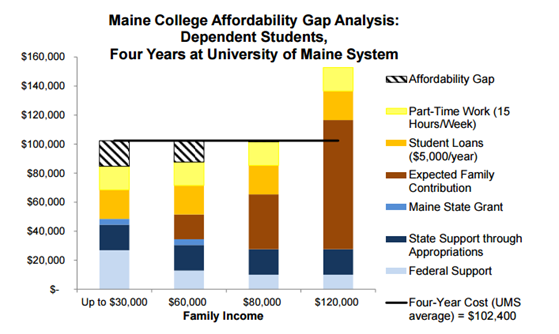For a PDF of this testimony, click here.
January 23, 2017
Good afternoon, Senator Langley, Representative Kornfield, and members of the Joint Committee on Education and Cultural Affairs. I am James Myall, a policy analyst with the Maine Center for Economic Policy (MECEP), and I am here today to testify in favor of LD 32.
Higher education is critical for creating a strong economy that works for all Mainers. Education is the best means for individuals to create a better future for themselves or their families, and an educated workforce benefits all of us by making the economy more productive and making Maine a good place for families and businesses. Unfortunately, a college education in Maine remains out of reach for many, and the increasing unaffordability of post-secondary education falls hardest on low-income Mainers – those most in need of a path out of poverty. Increasing the State of Maine Grant will help Maine’s economy work for everyone.
Nearly two-thirds of Maine’s class of 2015 graduated with student loan debt, averaging almost $30,000 per person.[1] Nationwide, student loans are now the second most common form of debt, after mortgages, accounting for $1.26 trillion.[2] This crushing debt load, which is increasingly comprised of high-interest private loans (rather than federal loans) has serious effects on the lives of newly-graduated. College debt restricts graduates’ abilities to purchase a home, start a small business, or save for retirement. It even causes young people to put off marriage and starting a family.[3] For a recent graduate in rural Maine, student loan bills can make a higher paying job out of state not just an option, but a financial necessity. Increasing the State of Maine Grant would ensure that Mainers’ education and career choices aren’t dictated by their financial situation.
Many Mainers clearly make the decision that the potential debt burden outweighs the benefits of college attendance. Maine has the highest proportion of adults without a college education in New England.[4] Even more concurringly, some 190,000 Mainers – one in five adults over the age of 25 – have some college credit but no degree.[5] Many of these individuals are in the worst of both worlds; burdened by college debt but with no credential to show for it. We know that low-income Mainers are less likely to attend college. Only 48% of low-income high-schoolers went to college in Maine, compared to 72% of those from better-off backgrounds.[6] Increasing the State of Maine Grant would help ensure that all Mainers have the same opportunity to succeed, regardless of income.
It’s important to realize that the costs of college extend beyond the price of tuition. While Maine’s university and community college systems have held down tuition costs since 2008, cost-of-living at in-state institutions remains high. For current University of Maine students, for example, room and board, supplies, and travel costs amount to twice the costs of in-state tuition (tuition accounts for just $8,370 of a total estimated cost of $23,992).[7] Many families also suffer the additional challenge of lost income from an adult child or parent pursuing an education in lieu of work.[8] Even with grant aid, college costs can eat up 70% of low-income Mainers’ resources.[9]
The tens of thousands of Mainers engaged in our University and Community College Systems graduate in often extraordinary circumstances. 80% of the students in public colleges in Maine are working or looking for work,[10] and nearly one in three women students is a mother.[11] Despite the high rate of employment, almost a fifth of public college attendees in Maine live in poverty, and more than a third live in near-poverty (less than 200% of the federal poverty level).[12] Increasing the State of Maine Grant would help Mainers enter and complete higher education, regardless of their personal circumstances.
Increasing the value of the State of Maine grant is long overdue. This committee’s own 2014 report on college affordability demonstrated that even with $5,000 in student loans, federal support, the State of Maine grant, and working fifteen hours a week, a student from a low-income family still faces a shortfall of $17,000 over a four-year degree period. Even for a middle-class student from a family with annual income of $60,000, the four-year shortfall is $15,000.

Source: State of Maine, Final Report of the Commission to Study College Affordability and College Completion, 2014.[13]
The State of Maine Grant is one of the smallest need-based grants awarded nationwide (see attached list of need-based grants), and total state spending is one of the lowest nationwide.[14] We know that increasing state aid in the form of grants to low-income residents works. Kentucky dramatically increased its state grant program, and saw its completion and graduation rates increase between 2000 and 2009, and the share of adults with higher education qualifications increased at the fastest rate of any state.[15]
I therefore urge the committee to adopt the legislation and increase the minimum grant under the State of Maine Grant program to $2,000. This is a step in the right direction to providing additional peace of mind to thousands of Maine students, to encouraging more Mainers to attend and complete college, and ultimately strengthening our state’s economy.
End Notes:
[1] http://ticas.org/posd/map-state-data#overlay=posd/state_data/2016/me
[2] https://www.newyorkfed.org/newsevents/news/research/2016/rp160524
[3] http://www.asa.org/site/assets/files/3793/life_delayed.pdf
[4] US Census Bureau, American Community Survey 2015 5-year estimates
[5] Ibid.
[6] https://www.mecep.org/maines-public-college-affordability-crisis-2/
[7] https://umaine.edu/stuaid/aid-basics/costs-at-umaine/
[8] Mitchell Institute. College-going in Maine: data brief. July 2014. Available at: http://mitchellinstitute.org/wp-content/uploads/2014/07/2014MaineCollegeGoing.pdf
[9] https://www.mecep.org/wp-content/uploads/2015/04/College-Affordability_final-draft_04-06-15.pdf
[10] MECEP analysis of American Community Survey 2015 1-year estimates, public use microdata.
[11] Ibid.
[12] Ibid.
[13] http://www.maine.gov/legis/opla/CollegeAffordabilityFinalReport.pdf
[14] Based on MECEP analysis of annual survey data from the National Association of State Student Grant and Aid Programs. Available at http://www.nassgap.org/viewrepository.aspx?categoryID=3#
[15] Ibid.


